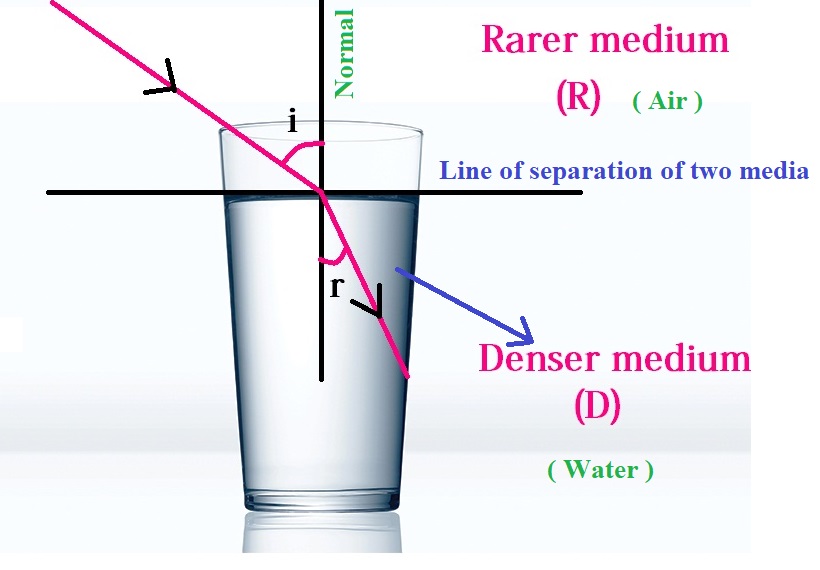Introduction :
In our dailylife, we may observe that the path of the rays of light have been bent when the these go from one medium to another medium at the separation of the two media. A man sees a fish under water. He tries to catch it but the fish senses the wave produced due to movement of hand in water by its lateral line and it runs away in another direction for safety. Why the man fails to catch the fish? Why the fish does not appear in its original position ? Why the stars appear to be in a position different from its actual position? In this chapter, we will discuss the phenomenon of light related to the answer of the above questions.

When a ray of light travels from one medium to another medium, due to change in density of the medium, the speed and wavelenght of the light wave change. For these reasons, the light bents at the interface of the two media. The bending of the light rays at the interface of the two media is called as the Refraction of light. Let’s discuss about reflection of light in details.
Definition of Refraction of Light :
The phenomenon of light in which the path of the light rays abruptly change at the separation of two media, is called as the Refection of Light.

Laws of Refraction of Light :

1 ) The incident ray, point of incidence, normal and refracted ray of light are coplanar.
2 ) The ratio of sine of angle of incidence and angle of refraction is constant. ( This constant term is nothing but the refractive index of the medium )
i.e, sin i / sin r = constant
Where i = angle of incidence
r = angle of refraction
Note : The sencond law of refraction of light is called as the Snell’s Law.
Refractive Index :
According to Snell’s law of refraction of light, the refractive index of a medium is nothing but the ratio of sine of angle of incidence to the angle of refraction. Actually it represents the density of a medium with respect to other medium.
There are two types of refractive index of a medium.
1 ) Absolute Refractive Index
2 ) Relative Refractive Index
Let n1 = refractive index of rare medium
n2 = refractive index of denser medium
Refractive index of rare medium with respect to denser medium = 2n1 = n1 / n2
Refractive index of denser medium with respect to rare medium = 1n2 = n2 / n1
1n2 * 2n1 = 1
Example 1 : Calculate the refractive index of galss with respect to water if nglass = 1.5 and nwater = 1.33
Solution :
Given that, nglass = 1.5 and nwater = 1.33
Refractive index of glass with respect to water = nglass / nwater = 1.5 / 1.33 = 1.128
Example 2 : Calculate the refractive index of water with respect to glass if nglass = 1.5 and nwater = 1.33
Solution :
Given that, nglass = 1.5 and nwater = 1.33
Refractive index of water with respect to glass = nwater / nglass = 1.33 / 1.5 = 0.887
Example 3 : Calculate the refractive index of galss with respect to diamond if nglass = 1.5 and ndiamond = 2.4
Solution :
Given that, nglass = 1.5 and ndiamond = 2.4
Refractive index of glass with respect to diamond = nglass / ndiamond = 1.5 / 2.4 = 0.625
Example 4 : Calculate the refractive index of diamond with respect to glass if nglass = 1.5 and ndiamond = 2.4
Solution :
Given that, nglass = 1.5 and ndiamond = 2.4
Refractive index of diamond with respect to glass = ndiamond / nglass = 2.4 / 1.5 = 1.6
Relation between Refractive Index of a Medium and Speed of Light in that Medium :
Let n = refractive index of a medium
v = speed of light in that medium
c = velocity of ligt in space or air or vaccum
n = c / v
n ∝ 1 / v
Hence, the speed of light varies inversely with the refractive index of a medium. That is,
n1 / n2 = v2 / v1
Example 1 : Find the value of speed of light in glass if the ray of light passes through air into glass. Given that, n = 1.5 and c = 3 * 108 m / s
Solution : Let v = speed of light in glass.
We know that, n = c / v
1.5 = 3 * 108 / v
v = ( 3 / 1.5 ) * 108
v = 2.0 * 108
Hence , required speed of light in glass is 2 * 108 m / s
Example 2 : Find the value of speed of light in water if the ray of light passes through water into glass. Given that, nglass = 1.5 and nwater = 1.33 and vglass = 2 * 108 m / s
Solution : Given that,
vglass = 2 * 108 m / s
vwater = ???
nglass = 1.5 and nwater = 1.33
We know that,
nglass / nwater = vwater / vglass
1.5 / 1.33 = vwater / ( 2 * 108 )
vwater = ( 1.5 / 1.33 ) * ( 2 * 108 ) = 2.25 * 108
Therefore, the speed of light in water is 2.25 * 108 m / s
Example 3 : Calculate the value of refractive index of glass if the light travels from glass to water. Given : nwater = 1.33 and vglass = 2 * 108 m / s and vwater = 2.25 * 108 m / s
Solution : Given that, nwater = 1.33
vglass = 2 * 108 m / s
vwater = 2.25 * 108 m / s
We know that,
nglass / nwater = vwater / vglass
nglass / 1.33 = ( 2.25 * 108 ) / ( 2 * 108 )
nglass= ( 2.25 / 2 ) * 1.33
nglass= 1.125 * 1.3
nglass= 1.49625 ≈ 1.5
The required refractive index of glass is 1.5
Relation between Wavelength of Light Rays in two different Media :
Let n1 = refrative index of incident medium
n2 = refractive index of refractive medium
λ1 = wavelength of light in incident medium
λ2 = wavelength of light in refractive medium
v1 = speed of light in incident medium
v2 = speed of light in refractive medium
Since, frequency remains constant during the refraction of light,
v ∝ λ
v1 / v2 = λ1 / λ2——————————————- ( 1 )
and we know that
v ∝ 1 / n
v1 / v2 = n2 / n1 ————————————– ( 2 )
By comparing equaitons ( 1 ) and ( 2 ), we get
λ1 / λ2 = n2 / n1
By invertendo, λ2 / λ1 = 1 / ( n2 / n1 )
λ2 = λ1 / 1n2
where 1n2 = refractive index of refractive mdeium with respect to incident medium. Let us assum that it is n.


0 Comments